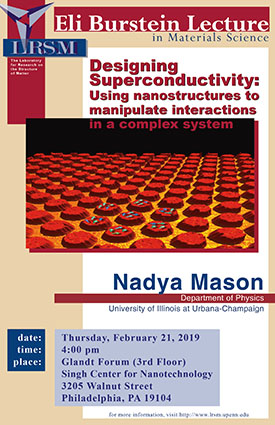Designing Superconductivity: Using nanostructures to manipulate interactions in a complex system


Associate Professor
Physics
University of Illinois
Thursday, February 21, 2019
4:00 pm
Glandt Forum (3rd Floor)
Singh Center for Nanotechnology
3205 Walnut Street, Philadelphia, PA 19104
download the poster
Abstract:
One of the most fundamental scientific questions is how the macroscopic properties of matter emerge from complex interactions of microscopic constituents. In this talk, I will discuss a “bottom-up” approach to studying collective effects in matter via coupled nanostructures. In particular, I will show how large arrays of superconducting islands fabricated on normal metal films can act as model, tunable superconducting systems. By changing the size and configuration of the islands, we can tune the parameters relevant to superconductivity, such as disorder and dissipation. I will discuss electrical transport measurements of these systems, including showing how we can control the phase transition, study dissipative behavior, and even create unusual superconducting states.
Bio:
Nadya Mason is a professor of Physics at the University of Illinois at Urbana-Champaign. She earned her PhD in physics from Stanford University and engaged in postdoctoral research as a Junior Fellow at Harvard University. A condensed matter experimentalist, Dr. Mason focuses on electron behavior in low-dimensional materials such as nanowires, graphene, and nano-structured superconductors. In addition to maintaining a rigorous research program and teaching, Dr. Mason works to increase diversity in the physical sciences. Dr. Mason was named a 2008 Emerging Scholar by Diverse Issues in Higher Education magazine, was a recipient of the 2009 Denise Denton Emerging Leader Award, the 2012 Maria Goeppert Mayer Award of the American Physical Society (APS), and was named an APS Fellow in 2018. She is a former General Councillor of the APS and Chair of the APS Committee on Minorities, and currently serves as Director of the Illinois Materials Research Science and Engineering Center (I-MRSEC).
